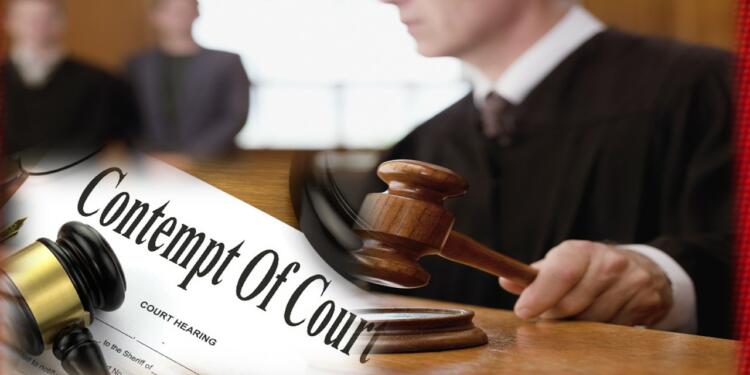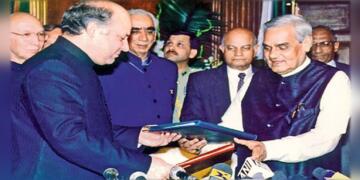Law is all about walking on the tightrope of conflicting principles. The biggest issue with practitioners of law is to do just that. Let us understand it in terms of the conflict between contempt of court and freedom of expression. For starters, it is not black and white. There is a middle ground while expressing your thoughts that can protect you from contempt proceedings.
Defining Contempt of Court
Contempt of Court has not been clearly defined in Indian parlance. What it means is that it is up to the courts to decide whether an action constitutes contempt or not. It is not absolute power, though. Contempt may not have been defined, but its types are defined under the Contempts of Court Act, 1971 (CCA, 1971). The act describes two types of contempt. One is civil contempt, and the other is criminal contempt.
Out of these two, civil contempt is easier to understand and subject to less interpretations. It is defined as “wilful disobedience to any judgment, decree, direction, order, writ, or other process of a court or wilful breach of an undertaking given to a court.” In other words, whatever the courts order you to do, you do it without any complaint or other negative emotion. For instance, if the court has given you an interim order of a temporary nature, even if it goes against your interests, you have to follow it.
Civil contempt
Now, if you are somehow not able to fulfil the obligations, the court will certainly initiate a contempt proceeding against you. In that scenario, you have to convince the court that you did not do it out of defiance. The court must be satisfied that your disobedience of their orders was not deliberate and happened only by fault.
It is pertinent to note that excuses, including technicalities and trivia, are not well-appreciated by courts in these proceedings. Even if the court has reasonable doubt that you have done it willfully, deliberately, and intentionally, you are liable for punishment.
The rule is a bit relaxed in case of delays in execution. Delay in execution is taken as an absence of intention to comply with the order. A reasonable explanation involving technicalities that delayed the implementation is sufficient to immunise the accused from punishment.
The last bastion of civil contempt is court judgments. In case you are not satisfied with the judgement and appeal to higher courts, there was some confusion regarding contempt proceedings. The Apex Court cleared it in the H. Puninder v. K. K. Sethi case. If the High or Supreme Court has not given a stay order, then not complying with the lower court’s order while the case is pending will mandate contempt proceedings.
Criminal contempt
Even disagreement with the lower court’s order is okay. However, slandering the functioning of the court, the judges, or any of the court’s functionaries is not. Then we delve into the domain of criminal contempt. Criminal contempt is a much broader concept and involves almost every aspect of daily life related to the court proceedings. It is also in very close conflict with the freedom of speech guaranteed under Article 19 of the Indian Constitution.
Virtually everything you do—speak, write, represent through cartoons, publish in newspapers, run as animation on TV screens, or use any other audio or video platform—can come under the ambit of criminal contempt. There are some conditions attached to the start of the criminal contempt proceedings.
Section 2(c)(i) of the Contempt Act mandates that any of the aforementioned forms of publication should not scandalise or lower the authority of any court in India. Moreover, even if the court sniffs any tendency to do it, a contempt proceeding can be initiated.
Section 2(c)(ii) of the act prohibits the publication of such information that prejudices, interferes with, or tends to interfere with the due course of any judicial proceedings. It involves the media interviewing key witnesses, accused, or any other important personality related to the Court.
Section 2(c)(iii) of the act prohibits the publication of any information that interferes or tends to interfere with, or obstructs or tends to obstruct, the administration of justice.
If you look closely at the aforementioned three sub-sections, it is easy to decipher that these mandates are draconian in nature. Virtually everything under the sun can be covered by it. This is the reason why there are certain exceptions to it as well.
Exceptions to criminal contempt
Section 3 of the act says that if a person or media house has published information innocently, then they are not committing contempt. The Court should be satisfied that they published it without foreseeing the consequences on the proceedings of that case. For this purpose, one must argue in court that they lacked the faculty to comprehend the consequences of their actions on court proceedings.
To put it simply, if a legal journalist argues that he published it without understanding the consequences, the court won’t accept it as a valid argument. A normal journalist can use this defence to a reasonable extent. The same applies for distributors of such publications too.
Section 4 allows for the publication of fair and accurate reports of judicial proceedings. Section 7 specifies the exceptions. Exceptions involve prohibition by courts on grounds of public policy or in the exercise of any power vested in them. One has to also ensure that they don’t publish secret processes, discoveries, or inventions that are brought up in proceedings. Additionally, while publishing, breaching public order, the security of the state also comes under Contempt of Court proceedings.
While the aforementioned criminal contempts rarely come to the fore, the tension regarding criminal contempt and criticism often does. The Act has provided a safety valve for criticism of the judiciary. Section 6 enables complaints against presiding officers of subordinate courts. Similarly, Section 5 enables fair criticism of judicial acts.
Defining “fair”
The keyword here is “fair.” It is a highly subjective word and, depending on the person’s standing on the moral spectrum, varies widely. That is why the word has evolved to hold centre stage in contempt proceedings. Fair has to be defined in judicial terms. It is a no-brainer to understand that evidence is the pillar on which the judiciary relies. Its emphasis on evidence is why the institution is respected.
Consequently, the word “fair” also has to have a strong correlation with evidence. So, when you criticise the judiciary, you should do it with evidence. Suppose you are criticising the poor functioning of a particular court; you have to ensure that they have proof regarding that.
This is the mistake that Prashant Bhsuhan committed when, on July 27, 2020, he tweeted that the Apex Court was responsible for destroying India’s democracy. Bhushan argued in court that it was his bona fide opinion. Argument was not accepted as it had no corroborative evidence attached to it.
Same mistake was committed by the infamous Justice C.S. Karnan. He accused numerous judges of corruption without presenting a shred of evidence. He was sentenced to 6 months in prison.
Criticism can’t be blind
Bhushan and Karnan were scandalising the court system, which is prohibited. In their attempts to criticise the Judiciary, they had gone as far as labelling baseless allegations against the Judges. Both even made personal attacks against the judges. These personal attacks are not acceptable. Certainly, it is reasonable to criticise a judge when he is acting as a judge, but not in his personal capacity.
So, Bhushan’s take on then-CJI Bobde on his bike was not a criticism of the judge. Instead, it was an attack on a Chief Justice living his personal life. It does not come under “fair and reasonable criticism,” laid down by the Apex Court in the Kapil Sibbal case.
These kinds of words harm the judiciary and foster distrust among the masses for institutions. It is the last independent bastion of a democracy, and degrading it casually is an unacceptable crime.
Also Read: Anti-conversion laws hit the radical Islamists where it hurts them the most
Rules to abide by
Simultaneously, the judiciary and legislative branches have provided enough scope to criticise the judiciary’s functioning. There are five basic rules to abide by when criticising anything.
Number 1-Follow the court’s orders in letter and spirit.
Number 2: Criticize the functioning of the court only with statistical evidence.
Number 3: While criticising any member of the judiciary, do not personally attack them.
Number 4: Criticise the words of Judgement and not the person writing or speaking the Judgement
Number 5: Publish judicial proceedings only when secrecy, public order, and national security principles do not prohibit it.
Not abiding by any of these rules may subject you to jail or a fine. Even a Rs 1 fine is extremely humiliating. It is more about accepting guilt than going scot-free with a cheap penalty.
Support TFI:
Support us to strengthen the ‘Right’ ideology of cultural nationalism by purchasing the best quality garments from TFI-STORE.COM

































